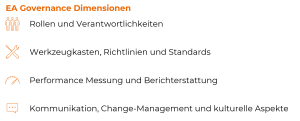Result
Effective EA Governance
Effective enterprise architecture governance is central to achieving an organization's strategic goals and ensuring efficiency and compliance. Without clear and enforceable governance structures, architecture decisions can be fragmented and inconsistent, leading to increased risk and inefficient processes.
Selected results of the workstream

1. Roles and responsibilities
Efficient roles with clear responsibilities are crucial for coordinated architecture development and a scalable design and implementation of governance. Examples of this are:
- Enterprise Architect (EA): Provides strategic leadership for enterprise architecture through strong business alignment and close collaboration with Solution Architects.
- Solution Architects and System Architects: Ensure architecture standards in projects and manage IT implementation.
- EA Governance Board: Balances management and content with clear decision-making mandates.
The challenges include unclear mandates, inconsistent control mechanisms, inefficient processes and a lack of integration. The success factors focus on strengthening governance in decision-making processes, consistent compliance with standards and efficient resource management.
2. Toolbox, guidelines and standards
Central tools and standards are essential for efficient EA governance. Best practices include:
- Differentiation between strategic and structural requirements.
- Definition of overarching governance principles such as transparency and clear framework conditions.
- Forming alliances with other specialist management departments, such as information security.
- Ensuring that requirements are as easy to understand and implement as possible and that compliance can ideally be checked automatically.
Challenges include low priority, lack of knowledge and unclear impact. The success factors include clear guidelines, participatory development and cooperation between disciplines.
3. Performance measurement and reporting
Transparent performance measurement supports corporate goals. Good practices include:
- Measurement of interaction with EA governance processes and tools.
- Verification of process compliance with a high degree of automation.
- Definition and validation of KPIs and PPIs to cover the entire process chain.
Challenges relate to organizational and technical hurdles, while success factors include management support, clear definitions and the selection of relevant KPIs.
4. Communication, change management and cultural aspects
Effective communication and involvement are crucial for successful EA governance:
- Company-wide anchoring of EA guidelines and documentation of deviations.
- Mandatory role-specific training.
- Dissemination of governance updates via various channels.
- Integration of EA checks in the EPIC flow or in project budget approvals and automation of approval processes.·
Unclear target groups, inconsistent structures and scaling problems are among the main challenges. These are offset by the success factors of stakeholder engagement, efficiency, automation and acceptance.
 Deutsch
Deutsch  English
English 